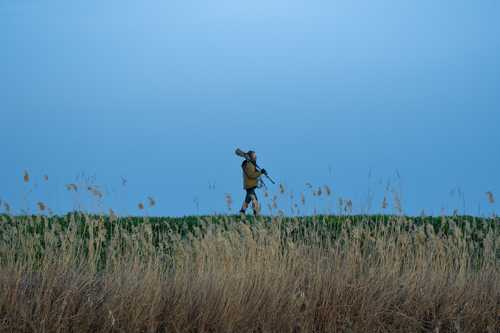
Finding the exotic on the doorstep: Interview with wildlife sound recordist Axel Drioli
Axel wears many hats: director, wildlife sound specialist, conservationist, and spatial audio designer.
With his brother Ario, he also runs the immersive production brand Sounding Wild. For their current project, Wings Across Continents, Axel and Ario are embarking on an overland expedition following the bird migration through Europe and West Africa with the goal of sharing stories about wildlife with local communities. The project was born out of the need “to really connect to nature”, and to develop an appreciation for nature around the world – but also hyper-locally, around our houses.
The brothers are currently partway through a year-and-a-half journey which is seeing them visit a different bird migration hotspot every month. For the first three weeks of each stop, Ario is taking photos and recording video, with Axel recording sound. In the fourth week, they are using that material to create an immersive installation using a 10.2 surround sound loudspeaker system and a pair of VR headsets. This will display a virtual video and photographic gallery of local bird species, encouraging communities from the area to connect more with the wildlife around them. “Once [participants] remove the headsets, they can go and experience [the natural world] themselves.”
Here, Axel speaks to earth.fm curator Melissa Pons about Wings Across Continents, listening deeply to both ourselves and the world around us, and the journey that took him from studying in London to recording Golden Jackals in the forests around his Italian hometown of Trieste.
I want to be in nature all the time, because to learn about nature you need to be in nature.
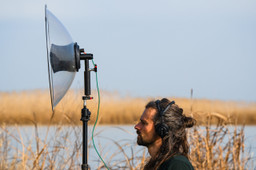
The following material has been edited for clarity. For the full interview – including thoughts on the freedom of walking alone in darkness, how walking blindfolded for a whole day in the city can change the way you listen to your surroundings, Axel’s favorite sounds and books, and grabbing people’s attention with nature sounds – please listen to the full episode of Wind Is the Original Radio, which is coming soon!
Wings Across Continents is a long project. Do you have previous experience of this kind of expedition?
Yeah, I was part of a couple of expeditions where we were making 360° documentaries in different parts of Africa. I was there with the UN and UNICEF, and everything was organized by a film production company. This time, my brother and I are overlanding in our own vehicles and have to find the locations ourselves, so it’s a different challenge.
Is any external organization involved?
We are collaborating with Wetland Link International. They support a network of wetlands around the world, and have an initiative called Migratory Birds for People which links all the visitor centers and wetlands on the East Atlantic Flyway, the migration route we’re going to follow.
We will be visiting a few places that are not part of this initiative, and are already in touch with most of them. So we’ve got help from an organization to put us in contact with them, but we don’t have, for example, financial support. So Wetland Link International gave us the connections and we have to create something with the local community and the local experts for those places.
How does it feel to be a white European reaching out to local communities? Particularly because you want to contribute by showcasing local nature, but will be seeking connection and some level of collaboration?
It is going to be a really interesting and really challenging expedition, because we don’t want to impose our stories and our way of telling them. The whole point is to inspire people by sharing the natural environments that they have there. Different cultures also have different ways of telling stories or perceiving stories or dealing with nature in general. Being in Africa doesn’t doesn’t mean that everybody is connected to nature. We cannot generalize people and a whole continent.
We are trying to be as honest as possible. When we go somewhere, we make people aware that we understand our position and we want to collaborate with communities, we want to collaborate with people, and then also leave a legacy behind. I think it’s very important to leave behind something that is meaningful – that could be a nice experience, financial legacy, or an educational legacy.
We don’t want to go there, grab something and go back to our hometown and then share the story only with our people. For us, it’s not only about the final outcome, a documentary that we’re going to make; it’s really important to create the story every month.
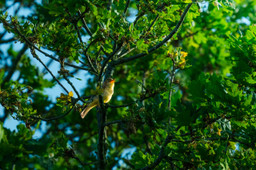
We are also really aware that, in the wider filmmaking industry, there’s a massive lack of films and documentaries being shown to local communities because, for example, distributors in the UK, Europe or US focus on their own countries; they don’t share much internationally. So there is a big problem in the wildlife natural history documentary industry already. We try to be fair and we want to also inspire other creators to do something similar, to take care of the local communities and engage with them much more.
On previous documentary expeditions, has any significant experience made you question something you took for granted?
Since my grandpa, I’m the first of my family to travel outside Europe. He fought in World War II as a soldier.
I’m originally from Northeast Italy, and the first time I went to Africa, it was to South Sudan. First day: one of the biggest refugee camps in Africa. And I was there holding my Sound Devices – six grand – capturing stories of kids who didn’t have anything. Some didn’t even have a name, didn’t have parents. And I started asking myself, ‘Why am I here?’
We captured the stories of a couple of kids. They gave us their time, but I’m not sure what we gave back to them. So there was a bit of a weird feeling. It didn’t feel right.
Then I went to Cambodia on my own, to record soundscapes and gibbons and hornbills in the Cardamom Mountains. And I found the story of a local ex-poacher, Chanda, then struggling with work, who was helped to become a ranger instead by a Spanish ranger.
That was interesting, so, in 2019, I directed and produced this as a 360° story. But I didn’t share it with Chanda and the other people there, and that wasn’t the right way of doing things. I should have given priority to them, not people in Europe and film festivals, just to make a living out. I’m trying to be more conscious about how I treat and think about other people.
Kenyan musician and field recordist Joseph Kamaru said that not everything is meant to be recorded. Some places and things are entitled to privacy. If this is something you think about, how do you apply it to the natural world?
I am against playing wildlife recordings to make other wildlife call back, in order to spot them. We don’t know exactly what those vocalizations mean in that context.
I think there are also situations where recordings shouldn’t be played back out of respect towards someone. ‘Why did you record it in the first place?’ That’s the question that we should ask ourselves.
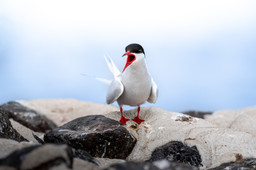
How did you come to nature field recording? And what attracts you to the sound of the more-than-human world?
I moved to London because I wanted to become a famous DJ, so I went to study at the SAE Institute. After four months, a friend put a pair of headphones on me: it was a “virtual barbershop”, which is a binaural recording, and it blew my mind. From that moment on, I was like, ‘This is what I want to do now.’ And so I entered the world of spatial audio.
I started researching surround mixes and making music with ambisonics and 20, 30 loudspeakers. But something was always missing. Music is meant, in my opinion, to be there, on the front stage. So I want to use the full 360° environment, soundfield that goes around me. I was like, ‘Where can I find something like this in our world? Oh, maybe soundscapes, urban recordings, or field recordings.’
I started recording in the city, recording cars passing by, but there was still something missing. And then I recorded some forest sounds, and by mistake I recorded a dawn chorus without even knowing what that was. I was an urban guy but I was like, ‘Damn, that sounds cool.’
I’ve done a couple of workshops with [post-punk musician and wildlife recordist] Chris Watson, and met other people who were into wild sound recordings, including the WildLife Sound Recording Society.
I started getting out in nature more and more; the technology that I loved, spatial audio, took me out of the studio and reconnected me to nature.
And the funny thing is, at the same time, my brother, Ario, who at the time was living in Brescia, near Milan, is a photographer and graphic designer and he started camping and taking pictures of nature. He also reconnected to nature because he was like, ‘I don’t want to stay in a studio taking pictures of people. I want to explore nature. I want to see the different colors, I want to see the imperfections, I want to see beautiful things that I didn’t expect would happen.’
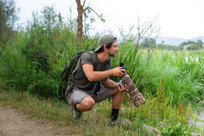
I want to be in nature all the time, because to learn about nature you need to be in nature.
We can’t talk about connection because we are nature ourselves. It’s just a matter of noticing it.
Do you practice deep listening? If so, what does that mean for you?
I think there are two ways of doing deep listening. I’m still learning, and sometimes I really struggle – mostly when I spend a lot of time in cities or working too much in front of a laptop. Deep listening, for me, is about not having barriers when I talk to someone that I don’t know. Don’t judge based on what they’re saying or how they look or whatever, just listen, take it in.
In terms of nature, sometimes I still fall into the trap of going for a walk because I want to listen – but then I still think about work or money or other people or whatever. But the worst is when I hear something and think, ‘Oh, that would have made a really great recording,’ before even thinking how great that behavior was.
I’ve been studying to understand how animals behave, so, instead of thinking, ‘Oh, that would have sounded great,’ I think, ‘Why did they sound that great? Why did they do it? What’s the reason behind it?’
When my brain starts thinking about why that sound has been made, that is, to me, deep listening, because I’m completely present there.
Is the experience of being in nature and listening very different from your daily life, when you are working or doing mundane activities?
Yeah, definitely. I’ve been meditating on and off for the past six, seven years now with the Headspace app, so I know what it means. The whole point of meditation is not to control anything, not to control your brain. It’s more about noticing thoughts.
When I’m out there, I’m trying to notice things that are present. And if I look at a phone, I’m not present in that environment; my thoughts are going somewhere else. But if I am present in that environment and I’m focusing on it – that is a sort of meditation for me.
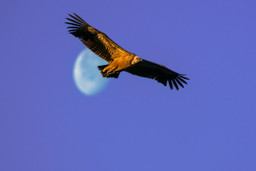
If someone who is trying to connect more to the world around them asked your advice, would you recommend this practice of simply going into natural environments and listening?
First of all, going to quiet places is a privilege now, isn’t it? It’s not something that you can access easily.
I lived in London for nine years and it’s been pretty hardcore at times. But, sometimes, I found places that weren’t too far away from my home that had just a little noise, but where the wildlife was so noisy that I was only focusing on that. So be aware of what’s around. Go into your own garden and really focus on what you’re listening to: not to the birds in general, but to that bird.
If we talk about nature sounds in Europe, that’s what we mostly hear: birds, biophonic sounds. Just go out there and start recognizing them. There are so many tools that can help us to recognize and get familiar with them. So, even though there is traffic noise or other anthropogenic noise, make it part of your day-to-day walk to work, and make sure that, if you hear animal or wildlife sounds, focus and learn them. Be curious about it.
I think that curiosity is important. If we go into nature and notice biodiversity, we start asking ourselves questions. It could be about birds or picking mushrooms or looking at moths. It could be anything that interests you. But that curiosity, I think, is really key: starting towards something, then digging deeper into it, that reconnects you to wildlife.
It could be just the sparrows that are outside your house, recognizing how many males and females there are. That’s connecting. And then you start listening to their different calls and start differentiating between alarm calls and songs. I don’t think going to a quiet place one weekend per month is the solution; I think it should be constant. It’s a slow process, like nature is slow.
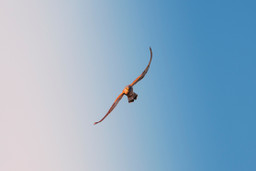
I was always excited about exotic sounds, so I traveled around Africa and Cambodia to look for exotic sounds. When I went back home and I was like, ‘Well, what’s going on here?’ We inherited a piece of land in a forest which was super quiet. So I left a recorder there for one night, unattended.
On the recordings, I hear these howling sounds. I didn’t know much about nature so I was like, ‘What? Do we have wolves near my house?’ They were Golden Jackals, a medium-sized [wild] dog like a wolf. They go around in packs and have been expanding all around Europe, coming from the Danube Delta in Romania and that area. I’ve been living in London, traveling all around the world to record exotic sounds, but there’s a wolf-like animal behind my house howling almost every night. That made me realize how much more we need to listen to our local environments.
Every time I go to my hometown, I drop a recorder there, but I can’t get close to them. I spent the last three years trying to get a good recording. And then one day I was in the bathroom doing my business at my mum’s place, close to a forest, and I hear howling 200 meters away. After three years spent walking up and down a hill with 20 kilos of equipment, they were just outside my doorstep. I dropped the microphone there and I’ve got a recording, the closest recording I could get. We don’t have to go too far to have crazy encounters with wildlife. It’s not a pristine recording, but, for me, it’s so powerful that this sort of thing can happen around our houses. We just need to notice it and hear it and be able to recognize it.
🎧 Listen to Axel Drioli’s recordings on earth.fm
Featured photo by Ario Drioli
All photos courtesy of Axel and Ario Drioli
Earth.fm is a completely free streaming service of 1000+ nature sounds from around the world, offering natural soundscapes and guided meditations for people who wish to listen to nature, relax, and become more connected. Launched in 2022, Earth.fm is a non-profit and a 1% for the Planet Environmental Partner.
Check out our recordings of nature ambience from sound recordists and artists spanning the globe, our thematic playlists of immersive soundscapes and our Wind Is the Original Radio podcast.
You can join the Earth.fm family by signing up for our newsletter of weekly inspiration for your precious ears, or become a member to enjoy the extra Earth.fm features and goodies and support us on our mission.
Subscription fees contribute to growing our library of authentic nature sounds, research into topics like noise pollution and the connection between nature and mental wellbeing, as well as funding grants that support emerging nature sound recordists from underprivileged communities.
